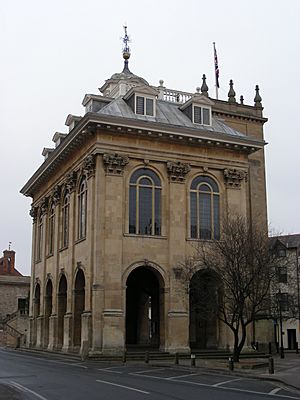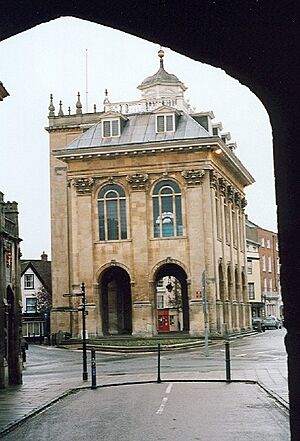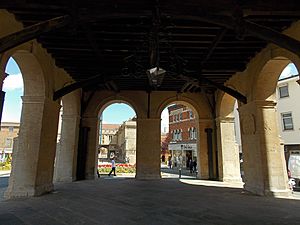Abingdon County Hall Museum facts for kids

View of the County Hall building that houses the museum.
|
|
| Lua error in Module:Location_map at line 420: attempt to index field 'wikibase' (a nil value). | |
| Established | 1678–1683 (building) 1919 (museum collection) |
|---|---|
| Location | Abingdon, Oxfordshire, United Kingdom |
| Type | Local museum |
| Collection size | Local history |
| Owner | Abingdon Town Council |
The Abingdon County Hall Museum, also called the Abingdon Museum, is a cool local museum. You can find it in Abingdon, Oxfordshire, England. The museum is managed by the Abingdon Town Council. It also gets help from the Abingdon Museum Friends, which is a registered charity. The building itself is very special. It's a Grade I listed building, meaning it's historically important.
Contents
The Museum Building's History
This amazing building was first built to be a county hall for Berkshire. Abingdon was the main town for Berkshire back then. It was used as a main court and office for the county's judges. The county hall was designed in the Baroque style. This style is known for being grand and dramatic.
Who Designed the County Hall?
The building was designed by Christopher Kempster. He learned his skills from Sir Christopher Wren. Sir Christopher Wren was a very famous architect. He designed St Paul's Cathedral in London. The County Hall stands on big pillars. There is a sheltered area underneath. This space was used as a market or for other town events. The building was finished in 1683.
A Grand Design for Abingdon
A famous expert named Nikolaus Pevsner once said something special about this building. He called it "the grandest" of all free-standing town halls in England. These are town halls with open ground floors. The building had a courtroom for important trials. This lasted until 1867. After that, these trials moved to Reading.
Royal Visit to the County Hall
The building had a big restoration project. This means it was carefully repaired and made new again. After this work, Queen Elizabeth II visited the town hall. This happened in November 1956. She signed the visitor's book. She also unveiled a special plaque.
What You Can See at the Museum
The museum started collecting items in 1919. It has many permanent collections. These are things that are always on display. The museum also has temporary exhibitions. These change several times a year. There are also smaller displays. These focus on local topics and change every month.
Special Items in the Collection
One interesting item is a copy of the The Monks' Map. This map shows the River Thames around Abingdon. It was made in the 16th century. The original map has been in the town's Guildhall since 1907. The museum also displays a copy of the Anglo-Saxon Abingdon Sword. The original sword was found in the river near Abingdon. It is now kept at the Ashmolean Museum in Oxford.
The Famous MGB Roadster Car
In December 2011, something very cool happened. The last MGB Roadster sports car was brought into the museum. This car was made in Abingdon in 1980. It was lifted 30 feet up through a window! This was done with help from British Motor Heritage. Now, you can see it in the museum's main gallery.
Museum Restoration and Reopening
From 2010 to 2012, the museum and building had a big restoration. This project lasted two years. Part of the money for this came from the National Lottery. The museum informally reopened to visitors in July 2012. An actress from the BBC show Horrible Histories, Martha Howe-Douglas, helped with this. The museum was officially reopened on March 8, 2013. This ceremony was done by the Duke of Gloucester. A new museum café was also opened in the basement.
See also
 In Spanish: Abingdon County Hall Museum para niños
In Spanish: Abingdon County Hall Museum para niños



